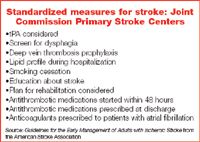New stroke guidelines stress speedy treatment
New guidelines for the treatment of acute ischemic stroke continue to endorse the use of intravenous tissue-type plasminogen activator while now including recommendations for palliative care.
With the recent death of Rev. Martin Luther King Jr.'s eldest daughter, Yolanda King, we lost an ally in the fight against stroke. King served as the first national ambassador of the American Stroke Association's (ASA) Power to End Stroke campaign and raised awareness in the African-American community about ischemic stroke prevention and survival.

"Our goal was to focus on the first hours after stroke onset, when time is so critical," asserted Harold P. Adams Jr., M.D., chairman of the guideline writing group and director of the division of cerebrovascular disorders, University of Iowa Stroke Center. "Many of the new recommendations are similar to those in previous statements, but with more emphasis placed on use of intravenous thrombolytics and a broader discussion of mechanical and intra-arterial pharmacological thrombolysis," he continued. "We are also pushing for the fastest possible treatment because with every minute that passes, the likelihood of a poorer outcome increases."
Although the guidelines call for more research on mechanical removal of blood clots and intra-arterial rtPA, they consider these techniques promising for patients with stroke onset greater than three hours or for patients who are not candidates for rtPA, such as those who have had recent surgery. Also included in the guidelines are new recommendations for palliative care of patients after a stroke. Supportive care should keep patients comfortable while supporting the families during situations of poor prognosis. Advance directives for stroke patients should be made available and honored.
The new guidelines also stress the importance of establishing hospitals as stroke centers and reaffirm the need for centers of excellence. "The goal is to improve stroke care across the country. So, eventually, emergency services may bypass hospitals without an operational stroke plan," explained Adams. "Patients should be treated at centers with expertise in stroke care, which can be done in a smaller community hospital if the institution provides the necessary resources and personnel."
The importance of educating the public on the analogies between a stroke and heart attack is also addressed. In cardiac disease, it is well documented that time is muscle. In stroke, it has now become the vernacular that "time is brain." Because the time window from arrival in the hospital to starting IV thrombolysis should be less than 60 minutes, pharmacists involved in managing stroke must have plans to rapidly dispense emergency medications; an acute stroke protocol would be an effective way to speed this process, he noted.
Samy Ayoub, Pharm.D., CGP, assistant director for clinical services at Community Medical Center in Toms River, N.J., also noted that "when pharmacists receive medication orders for stroke, they must realize that the faster the medication is dispensed, the better Any delay in delivering the medication can result in somebody losing vital life functions," he stressed.
THE AUTHOR is a clinical pharmacist in New Jersey.